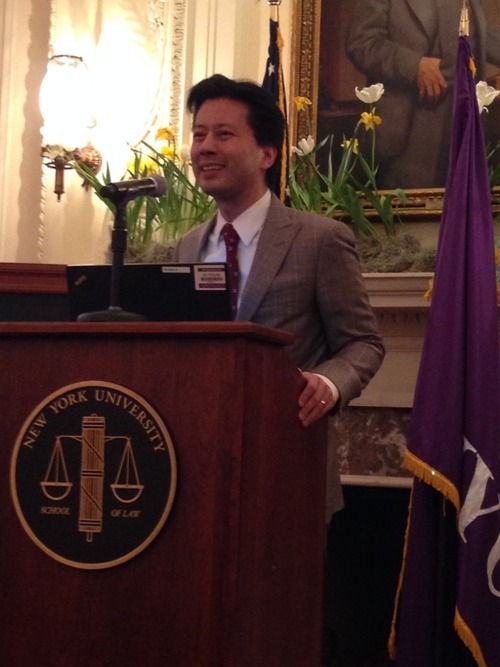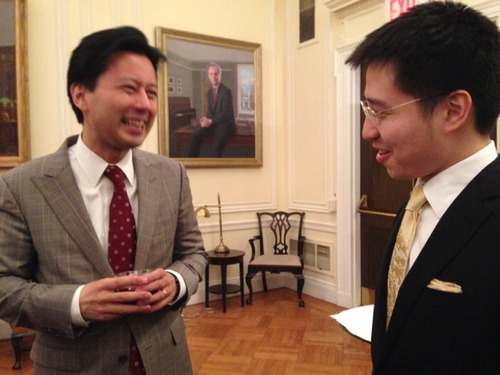At the 14th Annual Korematsu Lecture Series, presented by the NYU Asian-Pacific American Law Students Association, Chief Justice Earl Warren Professor of Constitutional Law Kenji Yoshino spoke about the phenomenon of ‘covering,’ discussed at length in his first book, Covering: The Hidden Assault on Our Civil Rights. The Korematsu Lecture Series, since 2000, has recognized Asian Americans whose work challenges legal boundaries and serves as an inspiration to all people of color.

Professor Kenji Yoshino touched upon his extensive research regarding the frequency of incidence and perceived impact of covering. As opposed to “passing,” the practice of concealing a part of one’s identity in order to present as a member of the dominant major, “covering” differs in that a person who covers is unable to completely conceal that part of his or her identity so must instead downplay qualities associated with it. In Prof. Yoshino’s words, “covering” is a tax that minorities have to pay in response to a much less visible second-wave discrimination. Examining both the demand and the performance of covering, the research explores whether certain professional organizations live up to their stated values of inclusion. Asking the question of whether certain groups feel as though they must cover in order to be successful and have their successes attributed to their personal qualities rather than their race, Prof. Yoshino identified four kinds of covering: (1) appearance-based covering (e.g. a black woman straightens her hair to downplay her race), (2) affiliation-based covering that avoids behaviors associated with identity (e.g. a mother avoids talking about her children because she does not want her co-workers to believe she is less committed to work), (3) advocacy-based covering that determines how much a person ‘sticks up’ for their group (e.g. a veteran lets a military joke slide lest he or she be seen as strident), and (4) association-based covering (e.g. a gay man does not bring his partner to work functions so as not to be seen as ‘too gay’).

In many ways, Prof. Yoshino’s research brings together many groups who feel the need to cover their identity, including the often elevated or demonized straight white males who feel they have to cover other factors, such as their socioeconomic background or their veteran status. At the same time, his findings also reveal the differences in impact respectively felt by members of different groups. Whereas most people feel the impact of covering, racial groups feel the impact to a greater degree, with no one impacted more than women of color who must simultaneously play down both their gender and race.
Here are some of the ways you could say I am “white”:
I listen to National Public Radio.
I have few close friends “of color."
I furnish my condo a la Crate & Barrel.
I vacation in charming bed-and-breakfasts.
I have never once been the victim of blatant discrimination.
I am a member of several exclusive institutions.
I have been in the inner sanctums of political power.
I have been there as something other than an attendant.
I have the ambition to return.
I am a producer of the culture.
I expect my voice to be heard.
I speak flawless, unaccented English.
I subscribe to Foreign Affairs.
I do not mind when editorialists write in the first person plural.
I do not mind how white television casts are.
I am not too ethnic. I am wary of minority militants.
I consider myself neither in exile nor in opposition.
I am considered “a credit to my race.”– Eric Liu, The Accidental Asian: Notes of a Native Speaker
"The loudest duck gets shot,” laughed Prof. Yoshino. Underscoring a dark history of discrimination, Prof. Yoshino explained how Asian Americans occupy a liminal space in which they are seen both as “honorary whites” and perpetual foreigners. Asian Americans cover or reverse-cover in numerous ways, either feeling pressure to live up to the model minority myth or feeling pressure to perform and act in certain ways to emphasize their Asian American identity. Professional Asian women are the least likely to have children. Asian Americans cover on the issue of age, often engaging in behaviors like wearing glasses or dressing conservatively in order to appear older and more authoritative.

(Above: Prof. Kenji Yoshino and former student and AABANY member George Hang.)
“Covering” gives a name to the phenomenon, which gives a person the tools to self-diagnose and consciously uncover. What is called for now by Prof. Yoshino’s research is self-reflection within organizations and communities. Having leaders who do not have to downplay their identities works to dismantle the harmful associations which might lead a person of color, mother, or other marginalized person to cover.

Prof. Yoshino closed with his own uncovering story: his own title, previously the “Earl Warren Professor of Constitutional Law” at NYU, had been a delicate issue in accepting his position. A Japanese American, Kenji Yoshino had been wary of taking on the title of the man who as Attorney General commissioned the internment of Japanese Americans during World War II. After much deliberation, the offer was again extended to Prof. Yoshino, appending the words “Chief Justice” – after the initial confusion, Prof. Yoshino learned that later in life as Chief Justice, Earl Warren had recanted and expressed his deep regret that he had ever done such a dishonorable action. In the spirit of the Chief Justice, Prof. Yoshino accepted the position – his research works to change perceptions and increase cultural awareness for the better, and that deeply matters, even over the course of one lifetime.
~
Special thanks to Prof. Kenji Yoshino, the NYU Asian Pacific American Law Students Association, and Hanah Kim and Ted Kim of the Korematsu Committee for continuing the tradition of education and inspiration!

